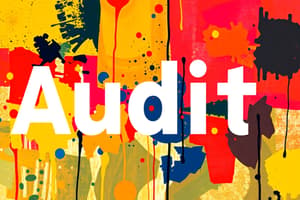Podcast
Questions and Answers
What is an IT audit?
What is an IT audit?
An IT audit is part of the audit procedures that auditors perform, focusing on the computer-based aspects of an organization’s information system.
Which of the following is NOT an internal control objective?
Which of the following is NOT an internal control objective?
- To ensure the accuracy and reliability of accounting records
- To safeguard assets of the entity
- To ensure product quality (correct)
- To measure compliance with management's prescribed policies
Which internal control principle addresses management's oversight?
Which internal control principle addresses management's oversight?
- Limitations
- Preventive Controls
- Methods of Data Processing
- Management Responsibility (correct)
What are the three types of controls in the PDC Model?
What are the three types of controls in the PDC Model?
Which framework includes Control Environment and Risk Assessment as components?
Which framework includes Control Environment and Risk Assessment as components?
IT governance focuses on management and assessment of strategic IT resources.
IT governance focuses on management and assessment of strategic IT resources.
What is one key objective of IT governance?
What is one key objective of IT governance?
What are the responsibilities of database administration?
What are the responsibilities of database administration?
What is one advantage of Distributed Data Processing?
What is one advantage of Distributed Data Processing?
What problem can arise from a centralized IT structure?
What problem can arise from a centralized IT structure?
Which of the following represents a control activity in the COSO framework?
Which of the following represents a control activity in the COSO framework?
Flashcards are hidden until you start studying
Study Notes
IT Audit Overview
- IT audit evaluates computer-based elements of an organization's information systems.
- Essential in modern systems using advanced technology for data management.
Internal Control Objectives
- Safeguard entity assets.
- Ensure accounting records' accuracy and reliability.
- Promote operational efficiency.
- Measure compliance with management policies and procedures.
Internal Control Principles
- Emphasizes management responsibility for controls.
- Considers methods of data processing and associated limitations:
- Error potential
- Circumvention of controls
- Management override
- Changing conditions
- Aims for reasonable assurance regarding control efficacy.
Internal Control Models
- PDC Model:
- Preventive Controls
- Detective Controls
- Corrective Controls
- COSO Framework:
- Control Environment
- Risk Assessment
- Information and Communication
- Monitoring
- Control Activities
IT Governance
- A part of corporate governance, focusing on strategic IT resource management.
- Main objectives include risk reduction and ensuring IT investments provide value.
- Covered topics include IT function structure, computer center operations, and disaster recovery planning.
Key IT Functions
- Database Administration: Ensures database security and integrity.
- Data Processing: Handles transaction processing, involving data control, computer operations, and data libraries.
- Systems Development and Maintenance: Analyzes user needs, designs new systems, and maintains existing systems.
Centralized IT Structure Challenges
- Separation of systems development and operational functions.
- Database administration divided from other tasks.
- Risks include inadequate documentation and potential for program fraud.
Distributed IT Structure Challenges
- Issues with resource efficiency and audit trails destruction.
- Risks of inadequate segregation of duties and hiring challenges.
- Benefits include cost reductions, improved control, user satisfaction, and backup flexibility.
Controlling Distributed Data Processing
- Implement a corporate IT function for oversight.
- Centralize testing of commercial software and hardware.
- Establish user services and standard-setting bodies.
- Conduct personnel reviews to maintain standards.
Audit Objectives and Procedures
- Objective: Verify appropriate segregation of incompatible IT functions to mitigate risk and foster a conducive working environment.
- Centralized IT Audit Procedures:
- Review documentation to identify incompatible function assignments.
- Examine systems documentation and maintenance records of applications.
- Ensure computer operators lack access to conflicting functions.
- Distributed IT Audit Procedures:
- Confirm the presence of policies and standards for system design and acquisitions.
- Verify distribution of corporate standards to all IT units.
Studying That Suits You
Use AI to generate personalized quizzes and flashcards to suit your learning preferences.




